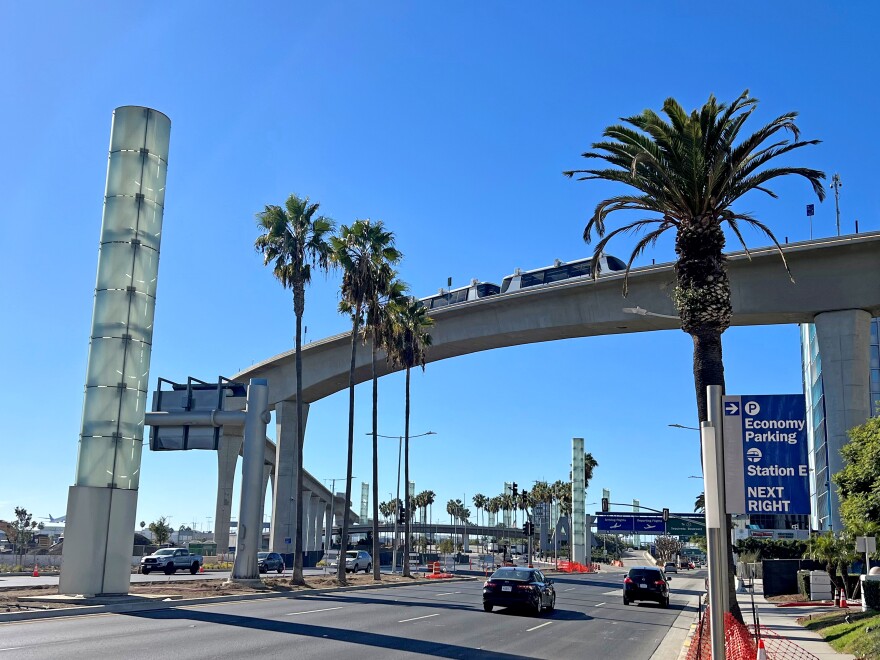Truth matters. Community matters. Your support makes both possible. LAist is one of the few places where news remains independent and free from political and corporate influence. Stand up for truth and for LAist. Make your year-end tax-deductible gift now.
What’s behind the latest LAX People Mover delay?

An ongoing dispute over maintenance of parts of the system that powers the LAX Automated People Mover could be the reason the long-awaited train won’t open until next summer, or even later, according to public documents reviewed by LAist.
The current dispute adds to a long series of disagreements between the city and LINXS, the group of companies contracted to design, build and operate the train, that have led to the ongoing saga of delays, hundreds of millions in cost overruns and diminishing public confidence that there’ll ever be a rail-only connection to LAX.
An L.A. County Civil Grand Jury report released earlier this year claimed that LINXS has used the dispute resolution process and “political pressures” to force contract extensions and additional compensation throughout the design and construction process.
In October, LAist reported about how the train’s estimated completion date moved from early 2026 to next summer. The dispute detailed in the public documents offers a more specific reason for the delay, which was previously opaque.
Dispute over metering cabinet equipment
In February, staff from city agencies directed LINXS to repair faulty equipment in a metering cabinet, according to a summary of the dispute and findings by a third-party evaluator. While the type of equipment isn’t specified, it’s likely related to measuring the power distributed throughout the system.
Power was partially shut down during the period of repair work, which lasted until July 2025.
That power shut-off delayed critical testing of the technology that allows for central control of the train’s systems, according to the third-party evaluator.
The third-party evaluator’s report said LINXS argued it was not required by contract to perform the repair work and is entitled to a schedule extension and compensation. The third-party evaluator, whose recommendations are not legally binding, agreed with LINXS’ position.
Los Angeles World Airports, the agency that manages LAX and the Van Nuys Airport, did not participate in an August hearing regarding the dispute, the third-party evaluator’s findings said.
The agency “rejected” the third-party evaluator’s conclusions, according to a November report from a management consulting firm retained by project lenders to monitor project progress.
What happens next?
According to the project contract, if a dispute remains unresolved after inquiring with the third-party evaluator, the next step is for LINXS to file a claim under a section of state law that governs complaints against public entities.
A section on the California Tort Claims Act on the Sacramento County Public Law Library website notes that the claim is a required precursor to any civil action.
“Filing a claim gives the agency the opportunity to settle the claim before a lawsuit is filed and to investigate the claim so that it can properly defend itself, or to correct the conditions or practices that led to the claim,” the website states.
The management consulting firm’s November report notes that LINXS “formally submitted” a claim on Oct. 21, triggering a 60-day period for the city to “respond to the claim and sets out the basis for the LINXS entitlements to relief.”
“Submission of [the] claim was explicitly requested by [Los Angeles World Airports] as a precursor to negotiation,” the report continues.
The status of the Automated People Mover
In a statement, Los Angeles World Airports said it’s not "unusual" to see "contractual disputes" on large capital projects like the Automated People Mover and that the train is still on schedule to open to the public next summer.
“LINXS continues to assure us the train will be ready for the FIFA World Cup, but we have back up plans in place to ensure an outstanding experience for all fans who visit Los Angeles,” the statement added. “[Los Angeles World Airports] does not comment on pending legal matters.”
Where did LAist find these documents?
LAist found the documents on a website that tracks municipal securities called Electronic Municipal Market Access (EMMA). To find the page relevant to the Automated People Mover, head to emma.msrb.org. Then, in the search box on the upper righthand corner, search for 13048VBA5. This CUSIP number as it is known uniquely identifies the $1.2 billion in bonds that the California Municipal Finance Authority provided for the Automated People Mover. Halfway down the page, select the “Disclosure Documents” tab, and you’ll see a list of documents, including the third-party evaluator’s findings, as well as the monthly reports from LINXS and the management consulting firm.
Construction on the project is nearly complete, and most of the current work is focused on testing and ensuring all the parts of the system work together.
In November, Fluor, one of the companies that makes up LINXS, reported to investors that they can expect the Automated People Mover to “reach substantial completion over [the] next 3 quarters.”
The Los Angeles Department of Water and Power, which was also named in the documents about the dispute, declined to comment.
LAist also reached out to LINXS and the companies that make up the group, but did not receive any response.
The management consulting firm also did not respond to emails requesting an interview.
Do you know something about the Automated People Mover that LAist should look into?
If you have a tip, you can reach me on Signal. My username is kharjai.61.
- You can follow this link to reach me there or type my username in the search bar after starting a new chat.
- For instructions on getting started with Signal, see the app's support page.
- And if you're comfortable just reaching out by email, I'm at kharjai@scpr.org











